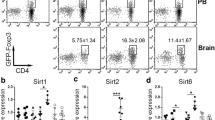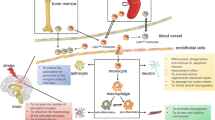Abstract
Regulatory T cells (Tregs) play an immunosuppressive role in various diseases, yet their function remains controversial in stroke and obscure in diabetic stroke. In the present study, Tregs were found downregulated in the peripheral blood of type 2 diabetes mellitus (T2DM) stroke models and patients compared with controls. In ischemic stroke mice (both T2DM and wild type), endogenous Tregs boosted by CD28SA increased CD206+ M2 macrophage/microglia cells, decreased infarct volumes, and improved neurological recovery. Our results demonstrated the potential of boosting Tregs for treating T2DM stroke. Furthermore, we utilized an optical imaging probe (IRD-αCD206) to target M2 macrophage/microglia cells and demonstrated its effect in visualizing M2 macrophage/microglia cells in vivo in ischemic brain tissue.





Similar content being viewed by others
References
Magnus T, Wiendl H, Kleinschnitz C. Immune mechanisms of stroke. Curr Opin Neurol. 2012;25(3):334–40. https://doi.org/10.1097/WCO.0b013e328352ede6.
Ting SM, Zhao X, Zheng X, Aronowski J. Excitatory pathway engaging glutamate, calcineurin, and NFAT upregulates IL-4 in ischemic neurons to polarize microglia. J Cereb Blood Flow Metab. 2019. https://doi.org/10.1177/0271678x19838189.
Wang R, Liu Y, Ye Q, Hassan SH, Zhao J, Li S, et al. RNA sequencing reveals novel macrophage transcriptome favoring neurovascular plasticity after ischemic stroke. J Cereb Blood Flow Metab. 2019. https://doi.org/10.1177/0271678x19888630.
Chamorro A, Dirnagl U, Urra X, Planas AM. Neuroprotection in acute stroke: targeting excitotoxicity, oxidative and nitrosative stress, and inflammation. Lancet Neurol. 2016;15(8):869–81. https://doi.org/10.1016/S1474-4422(16)00114-9.
Venkat P, Chopp M, Chen J. Blood-brain barrier disruption, vascular impairment, and ischemia/reperfusion damage in diabetic stroke. J Am Heart Assoc. 2017;6(6). https://doi.org/10.1161/JAHA.117.005819.
Kim E, Tolhurst AT, Cho S. Deregulation of inflammatory response in the diabetic condition is associated with increased ischemic brain injury. J Neuroinflammation. 2014;11:83. https://doi.org/10.1186/1742-2094-11-83.
Donath MY, Shoelson SE. Type 2 diabetes as an inflammatory disease. Nat Rev Immunol. 2011;11(2):98–107. https://doi.org/10.1038/nri2925.
Panes J, Kurose I, Rodriguez-Vaca D, Anderson DC, Miyasaka M, Tso P, et al. Diabetes exacerbates inflammatory responses to ischemia-reperfusion. Circulation. 1996;93(1):161–7.
Pellerin L, Jenks JA, Begin P, Bacchetta R, Nadeau KC. Regulatory T cells and their roles in immune dysregulation and allergy. Immunol Res. 2014;58(2–3):358–68. https://doi.org/10.1007/s12026-014-8512-5.
Ruhnau J, Schulze J, von Sarnowski B, Heinrich M, Langner S, Potschke C, et al. Reduced numbers and impaired function of regulatory T cells in peripheral blood of ischemic stroke patients. Mediat Inflamm. 2016;2016:2974605. https://doi.org/10.1155/2016/2974605.
Li P, Gan Y, Sun BL, Zhang F, Lu B, Gao Y, et al. Adoptive regulatory T-cell therapy protects against cerebral ischemia. Ann Neurol. 2013;74(3):458–71. https://doi.org/10.1002/ana.23815.
Liesz A, Suri-Payer E, Veltkamp C, Doerr H, Sommer C, Rivest S, et al. Regulatory T cells are key cerebroprotective immunomodulators in acute experimental stroke. Nat Med. 2009;15(2):192–9. https://doi.org/10.1038/nm.1927.
Na SY, Mracsko E, Liesz A, Hunig T, Veltkamp R. Amplification of regulatory T cells using a CD28 superagonist reduces brain damage after ischemic stroke in mice. Stroke. 2015;46(1):212–20. https://doi.org/10.1161/STROKEAHA.114.007756.
Schuhmann MK, Kraft P, Stoll G, Lorenz K, Meuth SG, Wiendl H, et al. CD28 superagonist-mediated boost of regulatory T cells increases thrombo-inflammation and ischemic neurodegeneration during the acute phase of experimental stroke. J Cereb Blood Flow Metab. 2015;35(1):6–10. https://doi.org/10.1038/jcbfm.2014.175.
Kilkenny C, Browne W, Cuthill IC, Emerson M, Altman DG. Animal research: reporting in vivo experiments—the ARRIVE guidelines. J Cereb Blood Flow Metab. 2011;31(4):991–3. https://doi.org/10.1038/jcbfm.2010.220.
Chow SZ, Speck M, Yoganathan P, Nackiewicz D, Hansen AM, Ladefoged M, et al. Glycoprotein 130 receptor signaling mediates alpha-cell dysfunction in a rodent model of type 2 diabetes. Diabetes. 2014;63(9):2984–95. https://doi.org/10.2337/db13-1121.
Bai YY, Gao X, Wang YC, Peng XG, Chang D, Zheng S, et al. Image-guided pro-angiogenic therapy in diabetic stroke mouse models using a multi-modal nanoprobe. Theranostics. 2014;4(8):787–97. https://doi.org/10.7150/thno.9525.
Zhang H, Xia Y, Ye Q, Yu F, Zhu W, Li P, et al. In vivo expansion of regulatory T cells with IL-2/IL-2 antibody complex protects against transient ischemic stroke. J Neurosci. 2018;38(47):10168–79. https://doi.org/10.1523/JNEUROSCI.3411-17.2018.
Cui X, Chopp M, Zacharek A, Cui Y, Roberts C, Chen J. The neurorestorative benefit of GW3965 treatment of stroke in mice. Stroke. 2013;44(1):153–61. https://doi.org/10.1161/STROKEAHA.112.677682.
Li P, Mao L, Zhou G, Leak RK, Sun BL, Chen J, et al. Adoptive regulatory T-cell therapy preserves systemic immune homeostasis after cerebral ischemia. Stroke. 2013;44(12):3509–15. https://doi.org/10.1161/strokeaha.113.002637.
American Diabetes A. 2. Classification and diagnosis of diabetes: standards of medical care in diabetes-2018. Diabetes Care. 2018;41(Suppl 1):S13–27. https://doi.org/10.2337/dc18-S002.
Iadecola C, Anrather J. The immunology of stroke: from mechanisms to translation. Nat Med. 2011;17(7):796–808. https://doi.org/10.1038/nm.2399.
Shukla V, Shakya AK, Perez-Pinzon MA, Dave KR. Cerebral ischemic damage in diabetes: an inflammatory perspective. J Neuroinflammation. 2017;14(1):21. https://doi.org/10.1186/s12974-016-0774-5.
McColl BW, Rothwell NJ, Allan SM. Systemic inflammatory stimulus potentiates the acute phase and CXC chemokine responses to experimental stroke and exacerbates brain damage via interleukin-1- and neutrophil-dependent mechanisms. J Neurosci. 2007;27(16):4403–12. https://doi.org/10.1523/JNEUROSCI.5376-06.2007.
Hearps AC, Martin GE, Angelovich TA, Cheng WJ, Maisa A, Landay AL, et al. Aging is associated with chronic innate immune activation and dysregulation of monocyte phenotype and function. Aging Cell. 2012;11(5):867–75. https://doi.org/10.1111/j.1474-9726.2012.00851.x.
Megherbi SE, Milan C, Minier D, Couvreur G, Osseby GV, Tilling K, et al. Association between diabetes and stroke subtype on survival and functional outcome 3 months after stroke: data from the European BIOMED Stroke Project. Stroke. 2003;34(3):688–94. https://doi.org/10.1161/01.STR.0000057975.15221.40.
Vignali DA, Collison LW, Workman CJ. How regulatory T cells work. Nat Rev Immunol. 2008;8(7):523–32. https://doi.org/10.1038/nri2343.
Liesz A, Zhou W, Na SY, Hammerling GJ, Garbi N, Karcher S, et al. Boosting regulatory T cells limits neuroinflammation in permanent cortical stroke. J Neurosci. 2013;33(44):17350–62. https://doi.org/10.1523/JNEUROSCI.4901-12.2013.
Hu X, Li P, Guo Y, Wang H, Leak RK, Chen S, et al. Microglia/macrophage polarization dynamics reveal novel mechanism of injury expansion after focal cerebral ischemia. Stroke. 2012;43(11):3063–70. https://doi.org/10.1161/STROKEAHA.112.659656.
Kanazawa M, Miura M, Toriyabe M, Koyama M, Hatakeyama M, Ishikawa M, et al. Microglia preconditioned by oxygen-glucose deprivation promote functional recovery in ischemic rats. Sci Rep. 2017;7:42582. https://doi.org/10.1038/srep42582.
Tiemessen MM, Jagger AL, Evans HG, van Herwijnen MJ, John S, Taams LS. CD4+CD25+Foxp3+ regulatory T cells induce alternative activation of human monocytes/macrophages. Proc Natl Acad Sci U S A. 2007;104(49):19446–51. https://doi.org/10.1073/pnas.0706832104.
Beyersdorf N, Gaupp S, Balbach K, Schmidt J, Toyka KV, Lin CH, et al. Selective targeting of regulatory T cells with CD28 superagonists allows effective therapy of experimental autoimmune encephalomyelitis. J Exp Med. 2005;202(3):445–55. https://doi.org/10.1084/jem.20051060.
Schmidt J, Elflein K, Stienekemeier M, Rodriguez-Palmero M, Schneider C, Toyka KV, et al. Treatment and prevention of experimental autoimmune neuritis with superagonistic CD28-specific monoclonal antibodies. J Neuroimmunol. 2003;140(1–2):143–52.
Guilliams M, Bosschaerts T, Herin M, Hunig T, Loi P, Flamand V, et al. Experimental expansion of the regulatory T cell population increases resistance to African trypanosomiasis. J Infect Dis. 2008;198(5):781–91. https://doi.org/10.1086/590439.
Beyersdorf N, Ding X, Hunig T, Kerkau T. Superagonistic CD28 stimulation of allogeneic T cells protects from acute graft-versus-host disease. Blood. 2009;114(20):4575–82. https://doi.org/10.1182/blood-2009-04-218248.
Beaudette-Zlatanova BC, Whalen B, Zipris D, Yagita H, Rozing J, Groen H, et al. Costimulation and autoimmune diabetes in BB rats. Am J Transplant. 2006;6(5 Pt 1):894–902. https://doi.org/10.1111/j.1600-6143.2005.01227.x.
Franco R, Fernandez-Suarez D. Alternatively activated microglia and macrophages in the central nervous system. Prog Neurobiol. 2015;131:65–86. https://doi.org/10.1016/j.pneurobio.2015.05.003.
Funding
This work was supported by the National Science Fund for Distinguished Young Scholars of China (NSFC, 81525014), National Natural Science Foundation of China (NSFC, 81830053), National Natural Science Foundation of China (NSFC, 81901809), Jiangsu Provincial Special Program of Medical Science (BL2103029), and the Key Research and Development Program of Jiangsu Province (BE2016782).
Author information
Authors and Affiliations
Corresponding author
Ethics declarations
The animal experiments were approved by the Institutional Animal Use and Care Committee (IAUCC) of the Medical School of Southeast University (Nanjing, Jiangsu, China; approval ID: SYXK-20130413275). All experiments were performed and reported according to the Animal Research: Reporting of In Vivo Experiments (ARRIVE) guidelines [15]. Human study was approved by the Independent Ethics Committee for Clinical Research of Zhongda Hospital, Southeast University as per the World Medical Association outlined in the Declaration of Helsinki (No. 2013ZDSYLL094.0).
Conflict of Interest
The authors declare that they have no competing interests.
Ethical Approval
We followed all institutional and national guidelines for the care and use of laboratory animals and the study of human subjects.
Additional information
Publisher’s Note
Springer Nature remains neutral with regard to jurisdictional claims in published maps and institutional affiliations.
Rights and permissions
About this article
Cite this article
Cai, Y., Xu, TT., Lu, CQ. et al. Endogenous Regulatory T Cells Promote M2 Macrophage Phenotype in Diabetic Stroke as Visualized by Optical Imaging. Transl. Stroke Res. 12, 136–146 (2021). https://doi.org/10.1007/s12975-020-00808-x
Received:
Revised:
Accepted:
Published:
Issue Date:
DOI: https://doi.org/10.1007/s12975-020-00808-x




